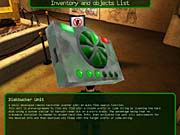The best adventure games let you explore diverse and exotic locales; they let you meet fascinating characters; they let you take part in a gripping story; and they let you solve puzzles that are challenging, but not frustrating, and reward you for solving them. Traitors Gate 2: Cypher does almost none of these things. There's a neat idea buried somewhere in the game of taking an old-school adventure game and throwing in a tiny dash of Tomb Raider and Splinter Cell. Unfortunately, Traitors Gate 2 is almost--literally--unplayable. The puzzles are arbitrary and too hard, the pace is boring, the gameplay is tedious, and the story is forgettable. If that weren't enough, major bugs and general sloppiness also mar the proceedings. In many ways, Traitors Gate 2 is a perfect example of how not to design an adventure game.

In the original Traitors Gate, you had to foil a jewel heist. In Traitors Gate 2, you again play as a mysterious operative named Raven, but this time around, the stakes are much higher: Global security is at risk. Terrorists from an unnamed Middle Eastern country are working with an American defector to develop a computer virus that can re-encrypt secret communications codes, thus crippling militaries and causing mass chaos. Your goal is to sneak into the lab where the virus is being developed. You must then copy the virus and destroy the lab. Conveniently enough, for an adventure game, you'll have to access the lab via an ancient Babylonian temple complex. This sort of old-fashioned pyramid crawl hearkens back to the earliest adventure games, like Scott Adams's Pyramid of Doom (1981).
Now, though, instead of a simple text adventure, you get the benefit of today's 3D technology. You control Raven as you would in a typical third-person action game, by moving him with the arrow keys and looking around with the mouse. Sadly, he can't jump or climb over even the tiniest of obstacles, and you can't remap the keys. Worse still, he frequently gets snagged on objects and sometimes spins about wildly. This is, at best, annoying and, at worst, is a contributor to your character's death as he gets caught up while trying to evade moving traps. The fact that you have to line Raven up perfectly with an object to pick it up or to operate it is equally problematic and can cause you to ignore a useable object that you, at first, might mistake as part of the immovable scenery. Still, getting to freely control a character's movement in a 3D environment at least, theoretically, makes Traitors Gate more immersive than your typical graphical adventure.
There's precious little in the way of interesting story or characters in Traitors Gate 2 to immerse you, though. For almost the entire game, the only character you see is Raven. You just watch the back of his head the whole while, and every great once in a while he'll make a stupid observation, like when he spots a serpent statue and says, "Whoa! Sir Hiss, I presume." So, the game is really all about the puzzles. During the great majority of the game, the puzzles revolve around lame "find the secret button to open the secret passage in the pyramid" dilemmas. Near the end of the game, you get to use a few high-tech gadgets to retrieve the terrorists' virus.
To help you progress through the mazelike temple complex, you use some clues from an archaeologist's old diary and sometimes use hints found on ancient paintings or carvings. Oftentimes, these clues aren't enough, and they can even confuse the matter. Almost-comically-gratuitous Rube Goldberg puzzles abound in numbing succession, often involving a whole bunch of levers and buttons and wheels and too little feedback about whether you're on the right track. Between the confusing clues and confusing puzzles, you can easily spend way too long stumbling about in this game, getting nowhere and growing utterly sick of the proceedings.
Even if you know what you're doing, some of the puzzles are so elaborate that they can take an eternity to finish, making this a painfully boring game. Just as bad, you rarely feel like you're making any progress. Good adventure games reward you for solving puzzles. They, of course, offer the simple satisfaction of having figured out a problem, but they also let you learn more of the story, explore neat new locales, and meet interesting new characters. In Traitors Gate 2, you miss all these things. It just feels like you're on a treadmill, facing one arbitrary puzzle after another and never earning anything for it. Just to make sure all your fun is squashed, the game suffers from some major bugs. For instance, you can sometimes fall through walkways, you can permanently freeze when you pull a lever, and you can suffer from other such similar things that may prevent you from completing the game.

Traitors Gate 2's presentation is a bit better than its gameplay, though it's still only mediocre. There are some believable ambient sounds, but sometimes the 3D audio makes them come from the wrong position. The soundtrack adds a little ambience but contains no memorable themes and doesn't add any real drama. Visually, the game looks dated and sputters and chugs as it loads new rooms on the fly. The endless, look-alike hallways aren't merely monotonous but can make navigation a chore. (Why isn't there an automapping feature?) On the bright side, the Babylonian temple setting is refreshingly unusual, and the developers clearly had fun with all the ancient Middle Eastern motifs and luxurious colors.
Traitors Gate 2 has a neat concept but totally fails to deliver on it. You never feel like some elite counterterrorist adventurer, but, rather, you feel like some poor schmuck who got suckered into wandering around a sprawling temple filled with one gratuitous, tedious, and frustrating puzzle after another. Couple that with major bugs, sloppy typos, and a painfully slow pace, and you get a mess of a game that feels more like punishment than fun.